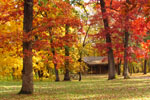JAMES PATE PHILIP STATE PARK
When people think of a state park, they often imagine significant or unique natural features that warrant the land to be protected for posterity. First-time visitors to James "Pate" Philip (formerly Tri-County) State Park may initially wonder what the area's specific feature is. After all, the land is predominantly old farmland that had been tilled and grazed for year. The north branch of Brewester Creek flows through the property, but most of the streambed had been channeled to move water away from the former agricultural field. Along the north boundary of James "Pate" Phillip State Park, starting in the east, a row of houses rises up like a wall against a sea of grasses. Further west along the boundary is an active gravel pit followed by the new Bartlett Park District sport field, and to the west of the park, across Route 25, is a landfill that is in the process of being closed.
However, the significance of James "Pate" Phillip State Park clearly appears after taking a closer look. First, the mere fact that this amount of land is preserved and protected from further development is significant. This land adds to the large block of open space to the south, which is currently preserved as the 3,432- acre Pratt's Wayne Woods Forest Preserve. Together, both spaces significantly improve the integrity of the natural processes throughout the region providing corridors that facilitate animal movement and seed dispersal. In addition, this area enables breeding populations of animals such as sandhill cranes, herons and Blanding's turtles to find undisturbed habitat to raise their offspring. And with any large block of preserved land, there is a potential for a higher diversity of animals and plants to exist, meaning more species to participate in the food web and water cycle.
Second, this land contains the remnants of one of the most diverse natural systems that ever graced the Illinois landscape, the tall grass prairie and its associated communities. Hidden among the overused landscape are pieces of a puzzle that represent what once was a rich tapestry of life. A remnant wetland also managed to survive in the center of this park. This wetland is home to an Illinois endangered species, the dwarf bur reed. This fact alone warranted this wetland to be listed as an Illinois Wetland Reserve in 1990.
The goal of James "Pate" Phillip State Park is to preserve these remnant pieces and to restore the ecosystems in order to support the highest possible level of biodiversity. Beginning in 1991, the state of Illinois developed the James "Pate" Phillip State Park Restoration Plan. This plan guided the initial restoration of the native landscape. Significant portions of the park have already been seeded to prairie. Prescription burns were introduced to contain woody growth encroaching on the prairie environment. In addition, drainage tiles along the east boundary were exposed and broken. This acted to slow the water flow from the park; now , instead of rapidly running off, the water collects and pools. By resaturating the soil, wet prairies and marshes will soon develop, creating habitat for many species of plants and animals such as the dwarf bur reed, the Blanding's turtle, the yellow-headed blackbird and a variety of migrating waterfowl.
The Illinois Department of Natural Resources has chosen to locate their Region II offices in the southeast corner of the park. In conjunction with this office, the state constructed the James "Pate" Phillip State Park Visitor Center, which opened in December of 2002 and is operated by the Forest Preserve District of DuPage county. This unique partnership will allow restoration and education to proceed hand in hand.
The visitor center highlights the reasons and the need for restoration to occur in natural areas, where ever they may be located. First, within the center, and exhibit details the impacts of human intervention over the years, such as fragmenting the landscape through plowing and building, clogging the natural waterways with chemical and sediment loading, and draining the land of water to enable farming and development to occur. Through visually stunning photomurals, interactive displays and activities, visitors discover the need to protect and restore the broken natural processes. Second, a small theater features videos that tell the story of this land - from the glaciers that sculpted the land to the explorers who discovered the land, the settlers, farmers, and developers who tamed the land, and the individuals who are now restoring the land.
Along with these fixed elements, there is a wide range of programming. Younger visitors are able to participate in hands-on activities designed to introduce the prairie and its animals through sensory-based programs. Older elementary school groups will begin to explore concepts such as the water and food cycles that enable the ecosystem to function. At this level, active restoration projects will be undertaken to model how individuals can help restore native lands. Older groups will also participate in active restoration work by monitoring natural areas for plant and animal life, assisting in the development of resource management plans for specific areas, and then actively working to increase the local biodiversity. From kindergartner to adult, there is a program for everyone.
As people visit James "Pate" Phillip State Park for the first time, they should remember that the story of this land is not completely told in what it is now but what this land will become. As the land recovers, the plant and animal life that once flourished throughout the area will return as well. Outdoor enthusiasts are encouraged to come back often and to watch this land transform itself into a functioning, diverse natural area.



